SpaceX successfully launches 20 Starlink satellites
SpaceX, led by Elon Musk, is working on a project called Starlink to provide internet access to the entire world using satellites. On Friday, October 19th, 2024, SpaceX launched another group of 20 Starlink satellites into space. Thirteen of these satellites have special technology that will allow people to use their cell phones directly with satellites. This is a big step towards providing internet access to places that don’t have good cell phone service.
SpaceX used a reusable rocket called the Falcon 9 to launch the satellites. After the launch, the first part of the rocket landed safely on a ship in the ocean. This shows that SpaceX is making space travel more affordable by reusing rockets.
Starlink Direct-to-Cell Technology
The 13 satellites equipped with direct-to-cell technology represent a significant advancement in SpaceX’s Starlink initiative. This technology will enable direct communication between cell phones and satellites, eliminating the need for traditional cell towers. This has the potential to provide connectivity to remote and underserved areas that currently lack reliable cellular coverage.
Initially, the direct-to-cell system will support text messaging, but SpaceX plans to expand its capabilities to include voice calls and data services in the future. This could revolutionize communication in areas with limited infrastructure, such as rural regions and disaster zones.
The Growing Starlink Constellation
With each launch, SpaceX adds more satellites to its Starlink constellation. As of now, over 6,400 Starlink satellites are in orbit, and the company plans to launch thousands more. This vast network of satellites will provide global internet coverage, enabling users in remote areas to access high-speed internet.
Despite the significant progress made by SpaceX, there are still challenges to overcome. One major challenge is the potential impact of large satellite constellations on astronomical observations. To mitigate this, SpaceX has taken steps to reduce the reflectivity of its satellites.
Another challenge is the regulatory landscape. As SpaceX expands its operations, it must navigate complex regulations and licensing requirements in different countries. International cooperation and collaboration will be essential for ensuring the successful deployment and operation of Starlink.
SpaceX’s ambitious vision for global connectivity has the potential to transform the way we communicate and access information. By leveraging cutting-edge technology and innovative business models, SpaceX is paving the way for a future where everyone has access to high-speed internet, regardless of their location.


Comments are closed.